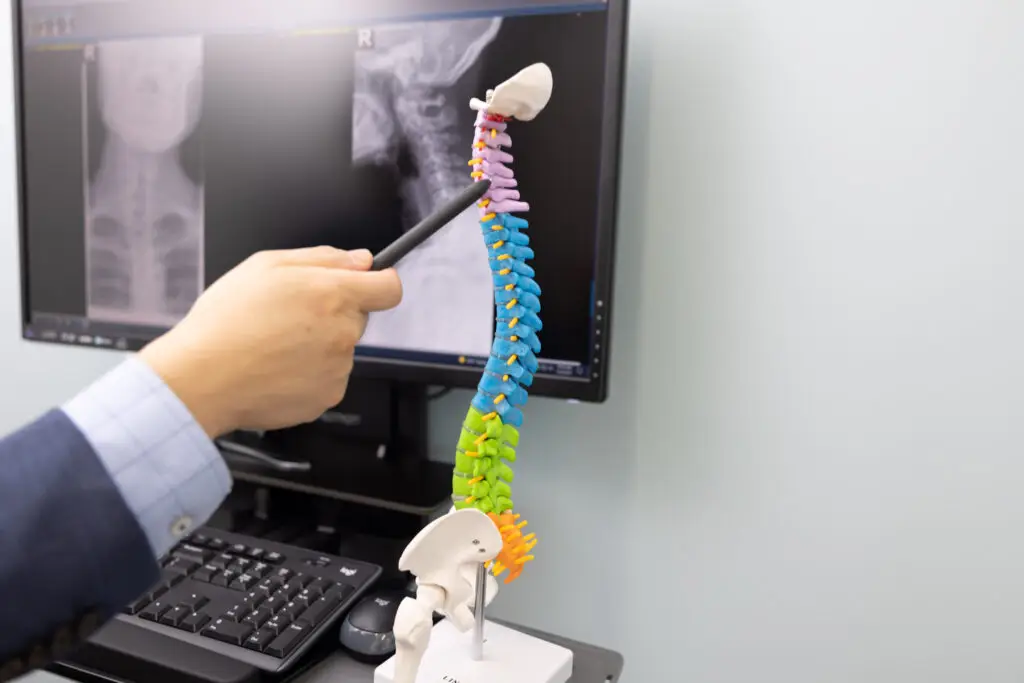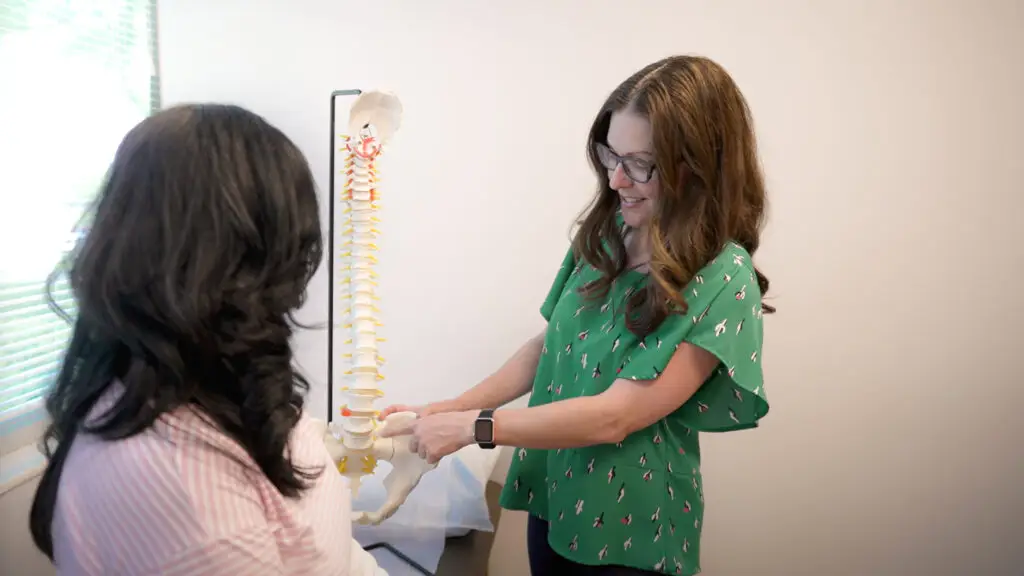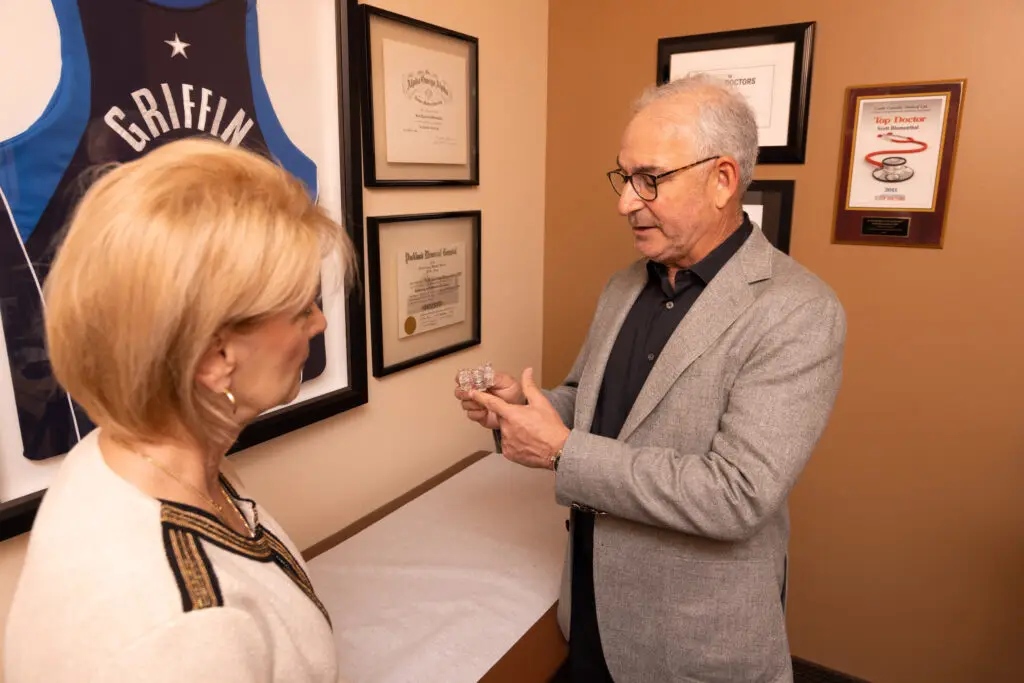Total Disc Replacement: A Body in Motion Tends to Stay in Motion
how we can help
Total Disc Replacement Overview
Sir Isaac Newton famously formulated three fundamental laws of motion. The First Law, also called the “Law of Inertia,” states that an object in motion will stay in motion unless acted upon by an unbalanced force. Conversely, an object at rest will remain at rest unless an external force is applied. Newton’s groundbreaking laws of motion laid the foundation for classical mechanics.
One of the most groundbreaking advancements in the field of medical technology and spinal treatment took place about 20 years ago. At the request of the U.S. Food and Drug Administration (FDA), leading spine surgeons at selected practices around the United States began exploring the feasibility of replacing damaged vertebral discs with those that were man-made.
Table of Contents
An artificial disc is an elegant concept because it restores motion between the vertebral bodies instead of fusing them to other discs and locking them in place. However, improving on what Mother Nature “created” is always a challenge. Fortunately, the spine specialists at Texas Back Institute (TBI) were up for the task.
Total Disc Replacement, or TDR, is a modern surgical procedure used to treat degenerative disc disease. It involves the surgical removal of a native disc, and in the space where the disc was originally located, an artificial disc is inserted. Also known as disc arthroplasty, an artificial disc replacement, or ADR, involves implanting a man-made disc that will enable the movement of the spine. The artificial disc is designed to mimic the biomechanics of a healthy spinal motion segment, allowing for controlled movement.
Now, let’s apply Newton’s Law of Inertia to artificial disc replacement surgery. Preoperatively, the patient experiences pain and limited mobility due to the degenerated disc. After disc replacement surgery, the artificial disc restores range of motion, allowing the spine to move normally without pain. The implanted disc acts as an “unbalanced force” that counteracts the inertia of the degenerated disc, enabling motion. Artificial Disc Replacement exemplifies how overcoming inertia – in this case, the immobility caused by a damaged disc – can lead to improved spinal function. This type of spine surgery highlights the complexities and the pre-operative considerations necessary for successful outcomes.
Rebuild-Restore-Renew
Texas Back Institute (TBI) is a pioneer in artificial disc replacement, performing the first procedure in March 2000. As a leader in spinal research and innovation, Texas Back has participated in more than 14 different FDA trials of both cervical and lumbar discs. Alleviating the pain caused by injured or diseased discs has been life-changing for TBI patients. Plus, these procedures and patient follow-ups have provided an extensive trove of data on the efficacy of this ground-breaking treatment.
Treats
Diagnosing
Diagnostic Tests:
Recovery
General Recovery Guidelines:
Patients Ask:
Am I a candidate for TDR?
Texas Back Institute Responds: Our spine experts are dedicated to conservative care, and this means surgery is always a last resort. This also means that not everybody is a candidate for total disk replacement. Most TDR patients present with severe back or neck pain that has not responded well to conservative care interventions – meaning physical therapy, chiropractic care, or injections. If a patient has been told they are a good candidate for spinal fusion, they may want to explore the option of artificial disc replacement.
Not Everyone Is a Candidate for Artificial Disc Replacement
There are several spinal conditions that preclude a patient from benefiting from artificial disc replacement. Anterior lumbar interbody fusion (ALIF) and Anterior cervical discectomy (ACD)are both alternative surgical options for treating nerve root inflamation or spinal cord compression.
For example, scoliosis, involves a significant curvature of the spine, will exclude a patient from TDR. Why? The device is not designed to adapt to this curvature of the spine.
Another group that are not good candidates are those with severe arthritic changes in the joints of the spine. This is because they will still be moving and will remain a source of pain. Finally, if a patient is not at ideal body weight they may have to get in better shape before they can be considered for artificial disc replacement.

Patients Ask:
Are there specific tests that will determine if I’m a good candidate?
Texas Back Institute Responds: Yes, X-rays of the spine will be necessary to see a patient’s standing spinal alignment and to make sure there’s no abnormal movement, or instability. An MRI will be performed to see how many discs are diseased and whether a bulging disc is pinching on nerves, or anything else that might be causing pain. A CT scan gives a different perspective than an MRI in that it allows the surgeon to closely observe the bones and the joints and make measurements to ensure that an implant will fit appropriately. Often, a DEXA scan, or bone density study, is done to tell us whether a patient’s bone density is normal or not. If it’s even slightly less than normal there is too high a risk of a fracture or failure – so that would eliminate you as a candidate for ADR.
Click here ((https://www.youtube.com/watch?v=_9eRrqYcyoE) for video on total disc replacement, featuring a pioneer in the procedure, Dr. Jack E. Zigler.

Lumbar Disc Replacement
Lumbar total disc replacement replaces the disc in the low back or lumbar region. ADR can significantly reduce chronic pain caused by a damaged or degenerative disc. A total disc replacement can relieve pressure on the spinal cord, reducing symptoms like numbness or weakness.
Patients Ask:
What happens during lumbar disc replacement surgery?
Texas Back Institute Responds: During TDR, the spine is accessed by coming in from the front of the body. That’s where the disc is in the spine. The spine surgeon is able to do this with the help of an access surgeon who moves other organs aside, allowing the surgeon to safely get to the disc space. The spine surgeon removes the diseased disc operatively. Surgeons replace the diseased disc with an artificial disc that restores both the height and the angle of the spine back to what it’s intended to be. Typically, patients who undergo artificial disc replacement heal faster than those who opt for the fusion procedure.
Cervical Disc Replacement
(illustration of the cervical area of the spine)
Cervical artifical disc replacement surgery, also known as cervical arthroplasty, involves removing a diseased cervical disc and replacing it with an artificial disc. Cervical arthroplasty is an alternative to cervical discectomy and fusion surgery, which permanently joins two or more vertebrae after removing the damaged disk. ADR allows for more movement and less stress on adjacent vertebrae.
Patients Ask:
What happens during cervical disc replacement surgery?
Texas Back Institute Responds: Surgeons make an incision on the side of the neck. It’s relatively pain free since the incision is small. The trachea and esophagus are moved to the side and blood vessels are moved so that the diseased disc can be removed using a high-powered microscope and ensuring that the spinal cord and all the nerves are completely decompressed. The device is implanted using an intraoperative X-ray so that it’s positioned appropriately. The incision is closed with dissolvable sutures. Some patients stay at the hospital overnight, especially if they are having multiple levels done, but many patients go home the same day.
Recovery From Total Disc Replacement Surgery
According to the American Academy of Orthopaedic Surgeons, most patients recovering from lumbar disc replacement will stay in the hospital for 1 to 3 days. The length of the hospital stay will depend on how well-controlled the pain is and a patient’s return to function.
In most cases, patients are encouraged to stand and walk on the first day after surgery. Because bone fusion is not required following artificial disc replacement, the typical patient is encouraged to move through the mid-section. Early motion in the trunk area may lead to quicker rehabilitation and recovery. Excessive motion should be limited, however, because the bone must heal to the artificial disc.

Patients Ask:
What is the recovery like from TDR?
Texas Back Institute Responds:
After cervical disc replacement surgery, the patient will be placed in a soft collar and they are normally discharged within 24 hours, in some cases it may be the same day, or they may stay overnight. Generally, the soft collar is worn to protect the wound. After the first visit two weeks, the patient will start general physical therapy. Because the disc replacement depends on the bone attaching to the prosthesis, the only restrictions we give the patient are to avoid hyperextension or looking up the ceiling and no impact loading – such as running – for the first 6 to 12 weeks, and the patient should not lift more than 10 pounds for the first 2 weeks. After 3 months, patients are released to full activity.
After lumbar disc replacement surgery, patients are generally up and walking the same day as surgery, and they are often discharged the day after surgery depending on the return of bowel sounds. Sometimes the bowels do not begin to have their normal peristalsis or squeezing activity right after surgery and a patient may have to spend an extra day in the hospital.
Patients wear a small corset for two weeks for wound healing, then return to their doctor and begin physical therapy. The only two restrictions they have are not to arch their back backward or to jog. Patients can return to non-laboring jobs after two weeks. At the end of the 3 months, patients are released for normal activities.
The Future of Medicine is at Texas Back Institute
Surgery is always the last option for the specialists at Texas Back Institute. However, if damaged or diseased discs are impossible to correct without surgery, artificial disc replacement could be a life-changing decision. Click here to set up an appointment today.
Learn more
Frequently Asked Questions
Our spine experts are dedicated to conservative care, and this means surgery is always a last resort. This also means that not everybody is a candidate for total disk replacement. Most TDR patients present with severe back or neck pain that has not responded well to conservative care interventions – meaning physical therapy, chiropractic care, or injections. If a patient has been told they are a good candidate for spinal fusion, they may want to explore the option of artificial disc replacement.
Yes, X-rays of the spine will be necessary to see a patient’s standing spinal alignment and to make sure there’s no abnormal movement, or instability. An MRI will be performed to see how many discs are diseased and whether a bulging disc is pinching on nerves, or anything else that might be causing pain. A CT scan gives a different perspective than an MRI in that it allows the surgeon to closely observe the bones and the joints and make measurements to ensure that an implant will fit appropriately. Often, a DEXA (link to the page) scan, or bone density study, is done to tell us whether a patient’s bone density is normal or not. If it’s even slightly less than normal there is too high a risk of a fracture or failure – so that would eliminate you as a candidate for ADR.
Click here ((https://www.youtube.com/watch?v=_9eRrqYcyoE) for video on total disc replacement, featuring a pioneer in the procedure, Dr. Jack E. Zigler.
During TDR, the spine is accessed by coming in from the front of the body. That’s where the disc is in the spine. The spine surgeon is able to do this with the help of an access surgeon who moves other organs aside, allowing the surgeon to safely get to the disc space. The spine surgeon removes the diseased disc operatively. Surgeons replace the diseased disc with an artificial disc that restores both the height and the angle of the spine back to what it’s intended to be. Typically, patients who undergo artificial disc replacement heal faster than those who opt for the fusion procedure.
Surgeons make an incision on the side of the neck. It’s relatively pain free since the incision is small. The trachea and esophagus are moved to the side and blood vessels are moved so that the diseased disc can be removed using a high-powered microscope and ensuring that the spinal cord and all the nerves are completely decompressed. The device is implanted using an intraoperative X-ray so that it’s positioned appropriately. The incision is closed with dissolvable sutures. Some patients stay at the hospital overnight, especially if they are having multiple levels done, but many patients go home the same day.
The artificial disc is then implanted using an intraoperative x-ray so that it’s positioned appropriately. The incision is closed with dissolvable sutures. Patients may be given a soft collar to wear to help protect the wound. Some patients stay at the hospital overnight, especially if they are having multiple levels done, but many times patients can go home the same day.
After cervical disc replacement surgery, the patient will be placed in a soft collar and they are normally discharged within 24 hours, in some cases it may be the same day, or they may stay overnight. Generally, the soft collar is worn to protect the wound. After the first visit two weeks, the patient will start general physical therapy. Because the disc replacement depends on the bone attaching to the prosthesis, the only restrictions we give the patient are to avoid hyperextension or looking up the ceiling and no impact loading – such as running – for the first 6 to 12 weeks, and the patient should not lift more than 10 pounds for the first 2 weeks. After 3 months, patients are released to full activity.
After lumbar disc replacement surgery, patients are generally up and walking the same day as surgery, and they are often discharged the day after surgery depending on the return of bowel sounds. Sometimes the bowels do not begin to have their normal peristalsis or squeezing activity right after surgery and a patient may have to spend an extra day in the hospital.
Patients wear a small corset for two weeks for wound healing, then return to their doctor and begin physical therapy. The only two restrictions they have are not to arch their back backward or to jog. Patients can return to non-laboring jobs after two weeks. At the end of the 3 months, patients are released for normal activities.
Locations


